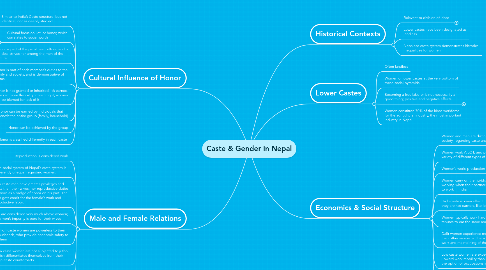Caste & Gender in Nepal
por Natasha Ayers


1. Male and Female Relations
1.1. Reproduction is considered work
1.2. The social system of Nepal’s caste system is inherently unequal regarding women.
1.3. High caste men have greater privileges and rights than their wives; her reproductive duties are worn as a badge of honor on his part. The male gets credit for the female’s work and reproductive labor.
1.4. Men are considered very much above women; even men’s impurity is pure for their wives
1.5. High caste women are powerless to their husbands, who provide economic safety to them
1.6. Low caste women are not subjected to jutho, which differentiates themselves from their high-caste counterparts
1.7. It’s less common for low caste women to look upon their husbands are “gods” as high caste women do
2. Lower Castes
2.1. Often landless
2.2. Women of lower castes at the very bottom of these social pyramids
2.3. Becoming a free laborer is not necessarily a good thing; positive and negative effects
2.3.1. Included
2.3.2. Included
2.3.3. Excluded
2.4. Women constitute 70% of the hired workforce for the agricultural industry, the most important industry in Nepal
3. Cultural Influence of Honor
3.1. Similar to India’s Caste structure, but not identical, nor as deeply studied
3.2. Cultural focus on ijat, or honor, which correlates to social worth
3.2.1. Define actions as necessary
3.3. Honor is part of the patrilineal culture, and is an ideal strived for among the men of the culture
3.4. Honor is part of each member’s duties to the family and society, and is demonstrative of status.
3.5. Honor is not granted or inherited; it’s earned. Men get more flexibility in earning it; women can be blamed for lack of it
3.6. Honor can be earned by individuals that benefit the entire group (family, household)
3.7. Honor can be achieved by the group
3.8. Honor is classified differently in each caste
4. Historical Contexts
4.1. Relevant to division of labor
4.1.1. Materials
4.1.2. Personel
4.1.3. Services
4.1.4. Duration
4.2. Lower castes have been designated as landless
4.3. Nepalese caste system demonstrates historical inequalities for women.
5. Economics & Social Structure
5.1. Women and men are distinctly different in this society, regarding caste and labor.
5.1.1. Schedule
5.1.2. Budget
